View crop
View crop Data sheet EcoPortAcacia nilotica
 |
|
| Notes |
|---|
| BRIEF DESCRIPTION A small to medium sized deciduous or nearly evergreen spiny tree reaching 10-20 m in height and a diameter of 30-80 cm. On poor sites it may only develop into a shrub. USES The wood can be used for carts, farm implements, tool handles, oars, boat-building, carving, turnery, pulpwood, mine timber, poles, fence posts, rail material, firewood, and charcoal. Bark and pods have a high tannin content. The tree provides a sweet, edible gum, it has medicinal properties, and it is a source of honey. Young foliage, young pods, sprouted seeds and shoots can be used as vegetables or fed to livestock. It can be planted as an ornamental, make a good hedge against grazing animals, be used for fire-breaks and for reclamation of alkaline waste lands or inundated areas and be used as a host for lac insects. KILLING T Moderately frost tolerant, but frost tender when young. GROWING PERIOD Perennial deciduous almost evergreen tree. Growing period per year 70-270 days (AGLS), 150-180 days (Edwards). It is generally grown on a 20 years rotation. COMMON NAMES Babul, Egyptain mimosa, Egyptian Thorn, Pickly acacia, Red-heat, Kudupod, Mgunga, Kiker, Kikar, Sunt, Babar, Jali, Nella tuma, Karu velam, Lekkerruikpeul, Ruikperul, Sunt. FURTHER INF Scientific synonym: A. arabica, A. arabica var. indica, A. nilotica var. indica, Mimosa nilotica. Babul is drought hardy, fixes nitrogen and regenerates rapidly. The tree occur naturally within the latitudinal range of 30°N-20°S. In the tropics it can be found at altitude between sea level and 1300 m. It thrives in dry areas. Mentioned as a possible agroforestry species. Photosynthesis pathway C3. Var."indica" is native to the Sind, Punjab, and Deccan areas of Pakistan and India, while var."nolitica" is native to Africa. "Nilotica" prefers clay, alluvial soils and tolerates long periodical inundations. Var. "adansoni" i prefers deep sandy-loamy soils, it usually indicates a high water table. In India, 600 trees/ha produced about 12 t of bark after 15 years. In Sudan the tree yields about 18 kg of de-seeded pods per year, and the yield of gum is up to 0.9 kg/year but often much less. | Sources |
| Grassland Index Duke J 1981 pp 9-11 317 [DRA, RAIN, TEMP, PH] Duke J 1975 pp 5 [PH, RAIN, TEMP] AGLS A 1991 Skerman P 1988 pp 519-522 [USE] Webb D 1984 pp 93 [RAIN, TEMP, TEXT, PH, DRA, FER, LIG, USE] Roecklein J 1987 pp 247 [USE] Edwards S 1984 pp 224 Aronson J 1989 pp 64 Troup R 1921 pp 419-444 [USE, TEMP, RAIN, TEXT, DRA, DEP, SAL] National RC 1980 pp 98 Puri S 1992 pp 46-2 INSPIRE species 10 [RAIN, TEMP, TEXT, PH, DRA, FER, LIG, USE] Maydell H 1986 pp 123-126 [DEP, TEXT, RAIN, TEMP, KTMP, USE] Little E 1983 pp 18-21 [RAIN, TEXT, DRA, FER, USE] Hensleight T 1988 pp 369 [TEMP, RAIN, TEXT, USE] Lemmens R 1991 pp 45-48 [USE, RAIN, DRA, TEMP, TEXT, SAL, PH, KTMP, LIG] |